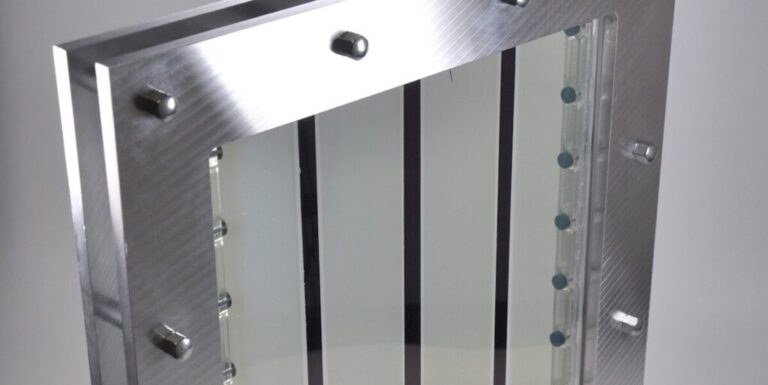Three Fraunhofer institutes in Germany have developed a tandem module for direct hydrogen production, as a modular, flexible alternative to large electrolyzers. PV is an additional power supply.
Three Fraunhofer institutes in Germany have developed “an exciting alternative” for the production of hydrogen using electrolyzers in the joint research project Neo-PEC. “PEC” stands for “photoelectrochemical cell”, a cell that allows direct splitting of solar water.
The solution from the research project, presented in June, consists of a module with an area of approximately half a square meter that can be connected to larger units and enables ‘highly flexible hydrogen production using solar energy’.
The “tandem PEC module” consists of two panes of float glass coated with semiconducting materials. One side absorbs short-wave light, while long-wave light penetrates the top layer of glass and is absorbed at the back. The module emits hydrogen at the back (cathode) and oxygen at the top (anode), with the two elements being separated.
During the three-year project, researchers developed high-purity semiconductor materials that were applied using “particularly gentle coating processes,” increasing hydrogen yield.
Ultra-thin layers measuring nanometers are built onto the glass via the gas phase, says Arno Görne, group leader for functional materials at the Fraunhofer Institute for Ceramic Technologies and Systems IKTS.
“The structures created have a major influence on the reactor activity, in addition to the actual material properties, which we have also optimized,” he said. The system is supplied with additional voltage via ‘photovoltaic elements’ in the module, which work ‘like a turbo, accelerating activity and increasing efficiency’.
Popular content
The result is a reactor that generates hydrogen separately from oxygen, which can be collected directly. Under European radiation conditions, as much as 30 kg of hydrogen can be generated with 100 square meters of module surface. This allows a hydrogen car to travel 15,000 to 20,000 km. By comparison, solar modules in Central Europe could generate about 16,000 kWh of electrical energy, enough to electrolyze about 300 kg of hydrogen.
According to Görne, the dimensions of the individual units are “limited by the fact that our module splits the water directly, but this also requires electricity to go from one side to the other. As the module surface increases, the increasing resistance affects the system.” The current format is optimal at this stage of development because it is “stable, robust and significantly larger than all comparable solutions.” An important advantage is the scalability of connecting multiple modules.
The other two institutes involved – the Fraunhofer Institute for Surface Engineering and Thin Films IST and the Fraunhofer Center for Silicon Photovoltaics CSP – conducted several field tests. They want to continue the collaboration in a follow-up project and plan to involve companies.
This content is copyrighted and may not be reused. If you would like to collaborate with us and reuse some of our content, please contact: editors@pv-magazine.com.


